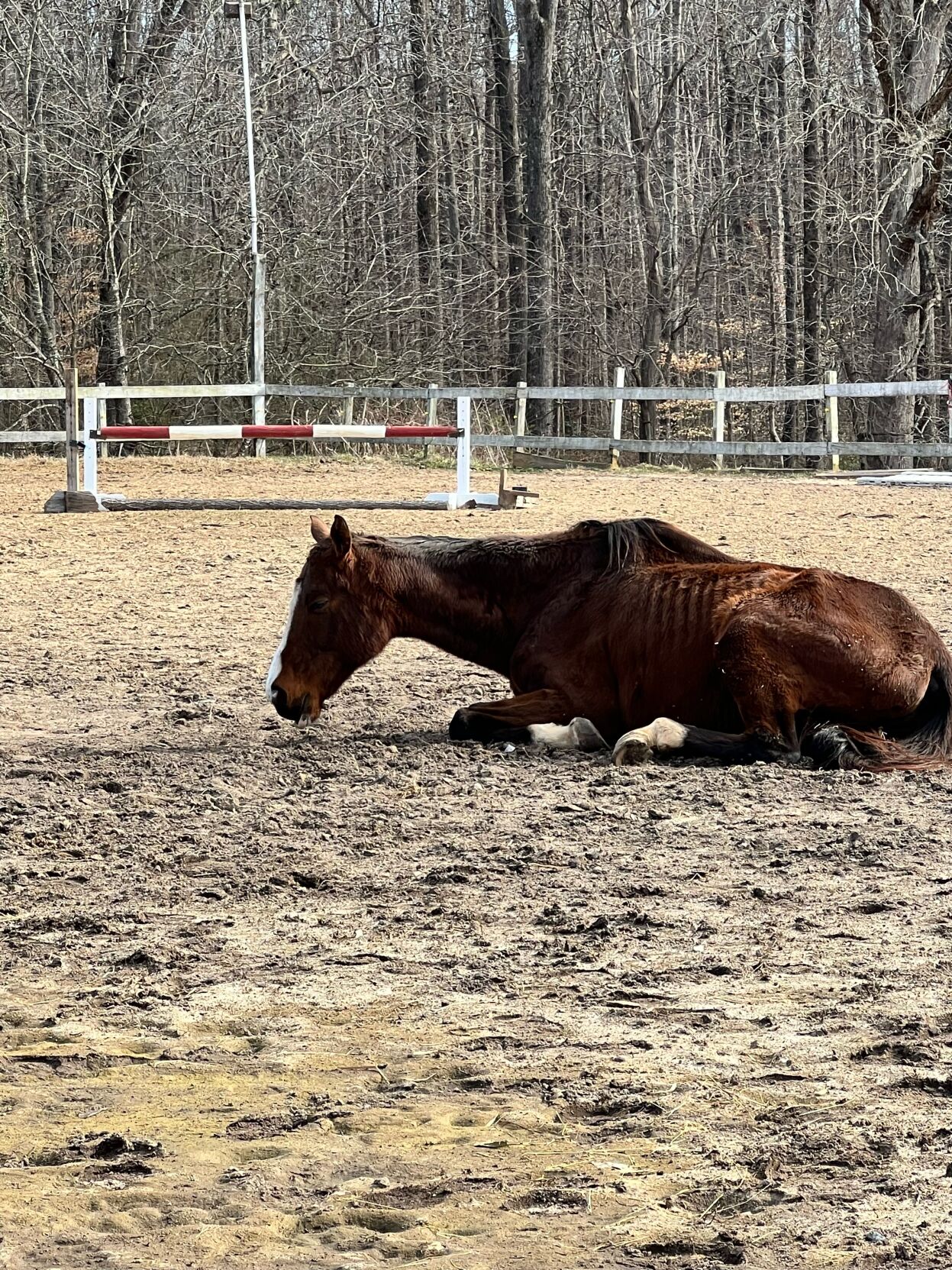Former horse show judge Byrd Rareshide has been sentenced to 100 days in jail, in addition to a five-year probationary sentence, for starving five horses staying at her Goochland County retirement farm.
The sentencing concludes a courtroom drama that captured the attention of the Virginia horse world and those who expressed shocked to learn of 13 animal cruelty charges filed against Rareshide last spring.
Rareshide runs a boarding facility for older show horses that have retired from their careers in the ring. She also served as an amateur judge with the Virginia Horse Shows Association, a position from which she was apparently removed shortly after publicity emerged around her animal cruelty charges.
People are also reading…

The horse Loki was found to have heart murmurs after being retrieved from the Byrd’s Nest farm in Goochland County. LORI CUSTER
Defense lawyer Craig Cooley argued Rareshide had been allowing her horses to thin as a way to avoid them becoming sick upon the arrival of fattening spring grasses. A string of veterinarians disputed the theory. One testified that a horse he received from her farm was “visibly starving.”
At least one died shortly after being removed from her farm, and several others recovered under attentive feeding programs. Several had heart murmur — a symptom that suggests a horse had begun to digest its own heart lining in search of nutrients.
In April, Rareshide was found guilty on five of the 13 counts brought by Goochland Commonwealth Attorney John Lumpkins Jr.
You can help us improve our coverage and deliver the news important to you. Here's how you can help.
The guilty charges correlate to the five horses who were found to be in the worst physical condition — Patrick, Terra, Opal, Loki and Ruby. All were former show horses who had been boarded at her farm, the Byrd’s Nest, to live out a bucolic retirement.
“This court has to place a greater weight on the testimony of experts,” said Goochland Circuit Court Judge Timothy K. Sanner at the conclusion of the trial, acknowledging that the pressures of economic inflation — and Rareshide’s own feeding philosophy — influenced his decision.
Rareshide’s total sentence is 12 months on each charge, but Sanner allowed for 11 months and 10 days to be suspended from each sentence.
The sentence also includes a five-year probation to begin upon her release.
Essential dog and cat safety tips for the hottest days of summer
1. Learn the signs of overheating in pets.

Pets can’t tell you when they’re too hot, but you can learn how to identify overheating behaviors. In dogs, signs of overheating include panting, labored breathing, drooling, shaking, disorientation, and bright red or blue gums, and lethargy. Overheating in dogs can progress to tachycardia, seizures, vomiting, or bloody diarrhea if they don’t get water.
Cats show similar signs of overheating: panting, confusion, drooling, staggering, and a bright red tongue and gums. They may also groom excessively or stagger when they walk. Like dogs, overheating can quickly progress into a serious problem for cats, leading to tachycardia, vomiting, and diarrhea.
2. Keeping your pets hydrated is essential.

Hydration is essential for preventing heating in cats and dogs. Keep fresh water bowls inside and outside your house so dogs and outdoor cats can grab a quick drink on hot days. You should also keep a portable water bottle on hand for hot summer walks.
Buy it here: Gorilla Grip No Spill Portable Dog Water Bottle with Built-in Bowl, $19
3. Grooming keeps your pets cool, but don’t overdo it.

Keep your dog or cat’s coat brushed and free from matting and tangles to help them maintain a healthy body temperature on sweltering days. According to the American Kennel Club’s Chief Veterinary Officer, Dr. Jerry Klein, shaving a double-coated dog could make them hotter. The inner coat insulates the dog and traps heat in the winter, but it also keeps cool air close to the skin in hot weather.
If your dog or cat is showing signs of overheating, give them water and a quick, cool bath to bring their temperature down before going to the vet.
4. Avoid hot pavement.

Walking your dog early in the morning or after sunset is the best way to avoid overheating on hot summer days, but it’s not always possible. If you have to walk your dog during the hottest parts of the day, walk them on shady sides of the street, in the grass, or with special dog booties.
Buy it here: PawZ Rubber Dog Boots, $20
6. Swim safely.

Some cats and dogs recoil at the sight of water, but others range from curious about it to big fans. If you want to cool off with your dog or cat in a pool, lake, or ocean, make sure you’re watching them at all times, and invest in life jackets for pets who love to swim.
Buy it here: Outward Hound Granby Splash Orange Dog Life Jacket, $16
7. Adjust your routine.

In addition to walking dogs early or late in the day when the weather is cooler, you should also adjust the amount of exercise you do. If your dog loves coming on your daily runs, make sure you’re not running at noon. If you go on long hikes together, save that activity for more moderate days. Likewise, indoor/outdoor cats should be kept inside when the temperature is too high. When the pavement is too hot for your hand, it’s probably too hot for your cat’s paws.











